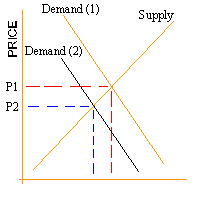The following should be a series of essays on various topics of international economics, hopefully fairly simple.
Economics is clearly an important element of the debate, and is clearly also one of the least understood elements
by those who object to the debate on globalisation. The following are a series of simple essays on various topics,
hopefully with the assumptions clearly laid out so as to invite discussion.
What happens when exchange rates change? What actions do private individuals and central banks take?
|
Taking the example of a change in confidence in the U.S. economy (which happened prior to the second Gulf War).
Investors lost confidence in the U.S. economy and began to move their money to Europe. Specifically, investors sold
treasuries in the U.S. and then sold the dollars for euros. In addition, fewer people wanted to come into the U.S. with new
money. As such the demand for dollars falls and the supply increases. This causes the exchange rate to fall from P1 to P2.
|  |
Central Banks tend to believe that large movements of the exchange rate can lead to large losses for traders and create
uncertainty in the market. There is not a great deal of evidence for their beliefs, but this is the theory. Thus the Central Bank
(in this case the central bank of the united states) will begin to buy up large amounts of dollars (using Euros) in order to move
the demand curve back towards the orginal (Demand 1) line. For simplicities sake, let us pretend the central bank wants to
extend the slide from one day to two. Thus on the first day it intervenes and buys up lots of Dollars, and the price of the dollar
falls to somewhere between P1 and P2. On the second day, the bank stops trading and lets nature (as it were) take its course.
The price of the dollar will fall to P2.
For those that missed why one would do this, imagine a firm (let's say a French auto supplier) had chosen this particular day
to send $100,000,000 home to France. And let's say the P1 price is one dollar per Euro. So they will sell 100 million dollars and get
one hundred million Euros and everyone is happy. But if the price has fallen to, say, 0.9 Euros per dollar, they will sell 100 million
Dollars and get 90 million Euros. Through no fault of their own they have lost 10 million Euros. But if the central bank intervenes to
prevent such a precipitous fall, they can get their trading through or retrench or choose another option. It gives them time to react.
If a central bank (and this is generally not true of the U.S. central bank due to the sheer volume of reserves it has available to it)
chooses to try and move the markets too much, one of two things will happen. If it buys too much of its own currency, it will deplete
its foreign reserves and be unable to influence the market in the future. This will leave the country open to price shifts. If, on the other
hand, it tries to lower the price of its currency by selling large amounts, it will lose control of the domestic money supply, because those
funds will go into the banking system, and banks will be free to loan them out to other people.
If a country wishes to raise or lower the price of its currency, a more effective way of influencing this is via interest rates
So now, how about the dollar value of imports, exports, and the U.S. balance of trade. If the dollar falls in value, what happens
to them? To begin with, it's important to remember who is buying dollars - people who want to buy goods and services from the U.S.
And who is selling dollars (for Euros, let us say)? People who want to buy things from Europe. So the supply and demand of dollars
is intimately related to the value of imports and exports. So let's examine what causes the supply and demand for imports to change
(with regard to exchange rates). Demand for U.S. exports will increase if (a) income in the Europe increases, (b) if the price
(in Euros) of our exports falls, or (c) if the price of European domestic goods rises. Supply of exports (from the U.S.) will change
if the price U.S. suppliers are receiving increases.
Here we have to make a few assumptions. Assume U.S. exporters only accept payment in dollars. Also assume European
importers are only concerned with the Euro price of goods.
| $1 = €1 | $1 = €0.5 |
| Price $ | Price Euro | Price $ | Price Euro |
| $1.00 | €1.00 | $1.00 | €0.50 |
